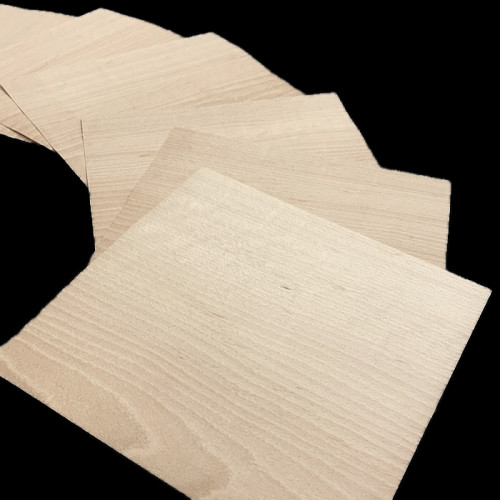
Natural Beech Small-size XXL Veneers
Natural Beech Small-size XXL Veneers
Genuine wood sliced-veneer sheets.
Fix length of 30 cm long.
Width: From 22 to 30 cm.
Thickness: 0.6 mm.
Sold by the sheet.
Natural Beech Small-size XXL Veneers
Genuine wood sliced-veneer sheets.
Dimensions:
Fix length of 30 cm long.
Width: From 22 to 30 cm.
Thickness: 0.6 mm.
Sold by the sheet.
Measurement scaling:
Width rounded to the covered centimeter: 15.8, giving 15 cm.
Species:
Common names:
<Beech, Natural Beech, Steamed Beech, European Beech.
Botanical name:
Fagus sylvatica
Origin:
If the oak is the king of our forests, the beech is the prince. It is the second most common species after the oak in our French forests.
Beech is present throughout the northern hemisphere from North America to Japan, but it is in Europe that the largest population is found.
The largest beech forest in Europe is located in Germany, in the Black Forest.
Mythology and history:
Beech has an important place in European mythology and history. Among the Greeks, it was dedicated to Zeus and symbolized strength and power. In the Celtic tradition, it was associated with the tree of life and wisdom.
Beech has also played an important role in human history. Its wood was used to make tools, weapons, and furniture as early as the Neolithic period.
Properties:
Beech is a hardwood, slightly heavier than oak, with an average density of 730 kg/m3 (compared to 670 kg/m3 for oak).
It is an ideal wood for indoor furniture, but it is strongly discouraged for outdoor use.
Indeed, beech is a wood that "moves" according to hygroscopic variations and is therefore not stable enough to be used on exterior joinery.
Remark:
Beech is a wood that takes stains well, which allows a wide range of finishes to be applied.
Easy to use, it can be cut, sculpted, and turned easily thanks to its firm texture and short grain.
Aesthetics:
Beech has a relatively uniform natural color, rather creamy white with slight pinkish variations. However, it is usually steamed by cooking in steam or boiling water, which evens out its color to a light pinkish-pale. Once a finish is applied, even colorless, the pinkish color becomes light camel.
Traditional uses:
In the Middle Ages, beech wood was used to make bows and arrows.
Contemporary uses:
Beech is used for the manufacture of furniture, flooring, stairs, chairs, high-end plywood (including seat shells and bed slats), and decorative veneers.
Beech is also used for the production of charcoal and firewood.
Product Description:
Genuine wood-sliced veneer sheets.
These veneers are raw without a finish or any fleece back.
The veneer surface is similar to plane wood. However, it will be preferable to forecast a light sanding after gluing.
The veneers are offered here as wood-sliced sheets of one and unique thickness.
Both faces of these veneers are the same, without fleece back, without glue.
Even if the veneer's sides had been cut relatively straight, it isn't a precise parallel clipping; some veneers may have kept the decreasing shape of the tree, wider at the bottom end and narrower at the top end.
Very occasionally, some veneers' sides have traces of unclipped wane, but our veneers are measured at the narrowest, as explained in the paragraph "sizes."
As genuine natural wood, all finishing products are acceptable as long these products are meant to be used for wood.
The choice of the finished product must be consistent with the final usage realization.
Use of the veneers:
Cutting:
Veneers can be easily cut with a utility knife.
For straight cuts, the best results are obtained with a veneer saw.
Use a fretsaw, scalpel, or veneer knife for curved cuts.
Always allow for a slightly larger veneer sheet than your intended surface. This will allow you to adjust the size after gluing for a clean finish.
A flush trimmer can also be used to trim the veneer after gluing.
When cutting with a utility knife or veneer knife, it is best to cut with the grain of the wood. To check this, run your finger along the edge of the sheet. The direction that feels smoothest is the ideal direction for cutting.
Gluing:
Several types of gluing are possible.
With vinylic glue, the veneer is pressed over its entire surface.
With neoprene glue for all surfaces, especially non-porous surfaces, by applying two coats of glue and marouflage.
With animal glue such as hide, sinew, or bone glue.
With vinyl glue and an iron, apply two thin coats of glue to each piece. This technique should only be used if other gluing techniques are not possible.
Sanding:
Veneers and all our products are wood and can be sanded according to their thickness.
Regardless of the thickness of the veneer, do not use a belt sander, as this could pierce it.
With a 0.6 mm veneer, lightly sand with 120 grit and then finish with 180 or 240 grit. With an orbital sander, 180 grit is already sufficient for most applications.
Finishing:
All finishing products generally used for wood are suitable for finishing our products. For example, you can use a varnish, wax, paint, or oil.
However, ensure that the product you want to use is compatible with the final use of your creation.
Photos:
To keep the cost of these products as cheap as possible and contrary to other veneers on this website, the pictures of small-size veneers do not represent the available stock.
More information:
Please look at our TUTORIALS; you might find some valuable tips.
Please contact us by email or phone for any additional information.
Data sheet
- Species
- Beech
- Thickness group
- Standard
- Width group
- Standard width
- Grade
- Unsteamed
 English
English




